Ijraset Journal For Research in Applied Science and Engineering Technology
- Home / Ijraset
- On This Page
- Abstract
- Introduction
- Conclusion
- References
- Copyright
Retrofitting of RCC Residential Tower for Two Additional Floors
Authors: Deepak Kumar, Mirza Aamir Baig
DOI Link: https://doi.org/10.22214/ijraset.2024.63254
Certificate: View Certificate
Abstract
The maintenance, rehabilitation and upgrading of structural members, is perhaps one of the most crucial problems in civil engineering applications. Moreover, a large number of structures constructed in the past using the older design codes in different parts of the world are structurally unsafe according to the new design codes. Since replacement of such deficient elements of structures incurs a huge amount of public money and time, strengthening has become the acceptable way of improving their load carrying capacity and extending their service lives. Infrastructure decay caused by premature deterioration of buildings and structures has led to the investigation of several processes for repairing or strengthening purposes. One of the challenges in strengthening of concrete structures is selection of a strengthening method that will enhance the strength and serviceability of the structure while addressing limitations such as constructability, building operations, and budget. Structural strengthening may be required due to many different situations. Retrofitting concrete structures is essential due to the aging and deterioration of infrastructure, exacerbated by advancements in construction technologies. Structural engineers encounter difficulties in selecting suitable methods or materials for retrofitting, which entails reinforcing existing structures with modern technology and features. This process can involve repair, rehabilitation, or strengthening, using techniques such as steel and concrete jacketing, fiber-reinforced polymer composites, shear walls, and shear cores. Typically, retrofitting methods increase stiffness and slightly add mass, necessitating redesign and column jacketing to adapt the structure to handle the additional load.
Introduction
I. INTRODUCTION
The majority of structural strengthening involves improving the ability of the structural element to safely resist one or more of the following internal forces caused by loading: flexure, shear, axial, and torsion. Strengthening is accomplished by either reducing the magnitude of these forces or by enhancing the member's resistance to them. Typical strengthening techniques such as section enlargement, externally bonded reinforcement, post-tensioning, and supplemental supports may be used to achieve improved strength and serviceability. Strengthening systems can improve the resistance of the existing structure to internal forces in either a passive or active manner. Passive strengthening systems are typically engaged only when additional loads, beyond those existing at the time of installation, are applied to the structure. Bonding steel plates or fiber-reinforced polymer (FRP) composites on the structural members are examples of passive strengthening systems. Active strengthening systems typically engage the structure instantaneously and may be accomplished by introducing external forces to the member that counteract the effects of internal forces. Examples of this include the use of external post-tensioning systems or by jacketing the member to relieve or transfer existing load. Whether passive or active, the main challenge is to achieve composite behavior between the existing structure and the new strengthening elements. Retrofitting techniques can be grouped into two categories: member-level Retrofitting and structural system-level Retrofitting [1]. Member-level retrofitting is aimed at improving the performance of individual deficient elements such as beams, columns, and the walls. The use of fiber composites and steel jacketing are some examples of this approach. The system-level retrofitting involves global modifications to the whole structural system [2]. The use of steel bracing system is one of the commonly used system-level retrofitting techniques. In the past, most of the reinforced concrete structures were designed primarily for gravity loads. They were also designed for lateral forces that may be much smaller than that prescribed by the current codes. An inadequate lap splice in the longitudinal reinforcement and absence of confinement in flexural hinge zones can significantly reduce the strength and ductility of a column. Structures which have such kinds of deficiencies can be prevented from earthquake damages by proper rehabilitation. Therefore, seismic retrofitting has become an important and popular topic among researchers which is studied and applied to seismically deficient structures. Many buildings have either collapsed or experienced different levels of damage during past earthquakes. Several investigations have been carried out on buildings that were damaged by earthquakes.
Low-quality concrete, poor confinement of the end regions, weak column-strong beam behavior, short column behavior, inadequate splice lengths and improper hooks of the stirrups were some of the important structural deficiencies (Yakut et al., 2005). Most of those buildings were constructed before the introduction of modern building codes. They usually cannot provide the required ductility, lateral stiffness and strength, which are definitely lower than the limits imposed by the modern building codes (Kaplan et al., 2011). Due to low lateral stiffness and strength, vulnerable structures are subjected to large displacement demands, which cannot be met adequately as they have low ductility.
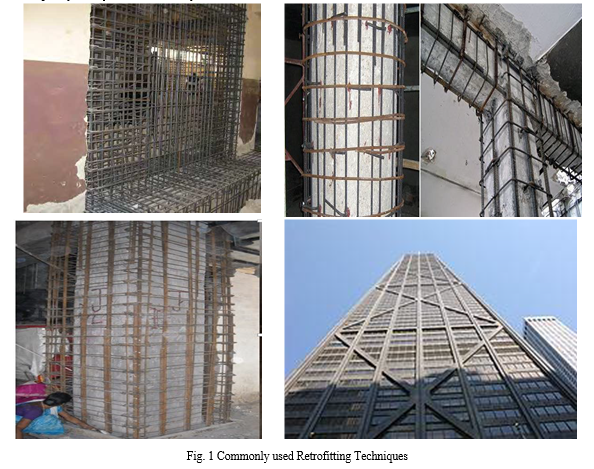
II. LITERATURE REVIEW
Recent earthquakes have shown the importance of retrofitting seismically deficient structures to achieve an acceptable level of performance. This can be achieved by improving the strength, stiffness, and ductility of the existing structures. Significant advancements have been made in the research and development in this field. The rehabilitation of infrastructures is not new, and various projects have been carried out around the world over the past few decades. One of the techniques used to strengthen existing reinforced concrete members involve external bonding of steel plates by means of two-component epoxy adhesives. By this way, it is possible to improve the mechanical performance of a member. The wide use of this method for various structures, including buildings and bridges, has demonstrated its efficiency and
its convenience. In spite of this fact, the plate bonding technique presents some disadvantages due to the use of steel as strengthening material. The principal drawbacks of steel are its high weight which causes difficulties in handling the plates on site and its vulnerability against corrosive environments. Moreover, steel plates have limited delivery lengths and, therefore, they require joints. There are various rehabilitation techniques and to select the appropriate one, an accurate evaluation of the condition and seismic performance of an existing structure is necessary.
An overall evaluation of the seismic performance of an existing structure can be conducted by four different procedures: the linear static procedure, the linear dynamic procedure, the nonlinear static procedure (push-over analysis), and the nonlinear dynamic procedure. After analyzing the structure, the most convenient rehabilitation technique can be chosen. In the system strengthening, new elements are added to a building to enhance its global stiffness. With an increase in the stiffness, the natural period of vibration of the building is to decrease. This, in turn, will result in a decrease in the amount of horizontal displacement that must be achieved by the building to resist earthquakes. When the building has enough stiffness, it will no longer able to achieve the amount of displacement which would cause it to collapse. Moreover, addition of new members to the building shall mostly increase the horizontal load capacity of the building as well (Canbay et al., 2023). The increased capacity will therefore require greater ground motions to allow the building to develop a yielding behavior. Thus, it can be said that the system strengthening does not only prevent collapsing but also delays structural damages. More clearly, the damage level of a building which is expected to sustain significant damages during a medium intensity earthquake may be reduced to minimum levels when it is strengthened by system strengthening techniques.
III. OBJECTIVES
- To retrofit the existing RCC structure for the additional two floors.
- To identify the structural components where retrofitting is mandatory.
- To choose the method of retrofitting of the structural elements.
- To enhance the sizes of structural members for resisting the additional loads.
- To compare the variation in forces and moments in the foundation level, before and after the addition of two storeys, a contour diagram will be plotted.
- To design the suitable bracing system for the entire building in order to resist the seismic load efficiently.
- To check the lateral displacement of the structure with and without bracings before and after the addition of two floors.
- To compare the cost of each retrofitting method to achieve the economy in the design.
IV. System Based Strengthening Techniques
Most of the strengthening strategies have recently been based on global strengthening schemes as per which the structure is usually strengthened for limiting lateral displacements in order to compensate the low ductility (Sonuvar et al., 2004). In these methods causing a change in the global behavior of a building, as explained above, a behavior change takes place when new members are added to the building. For a building which is currently used, it is important that the new members which are to be added to the structure are few in number and they are designed to ensure a significant increase in the load capacity and stiffness of the structure.
A. Infill Shear Walls
Among the global strengthening methods, addition of RC infill is the most popular one. Many researchers have focused on the addition of infill RC walls and found that the installation of RC infill walls greatly improves lateral load capacity and stiffness of the structure. Even in cases of application to damaged buildings, the infill method can yield satisfactory results (Canbay et al., 2003; Sonuvar et al., 2004).
B. External Shear Walls
Although the use of shear walls becomes widespread due to the fact that they are effective strengthening elements, they are also known to result in some difficulties hence they require a great deal of demolition and construction works in the existing structure. Application of external shear walls is an approach introduced to diminish such difficulties (Sucuoglu, 2006).
C. Steel Bracing
Steel bracing for RC frames has also been used to reduce drift demands. Bracing can either be implemented inside the frame (Masri & Goel, 2000) or applied from outside of the system (Bush et al., 2000) like RC walls. Post-tensioning can also be applied to bracing elements (Gilmore et al., 1996). In either case, steel bracing offers more suitable solutions in aesthetical terms for numerous applications.
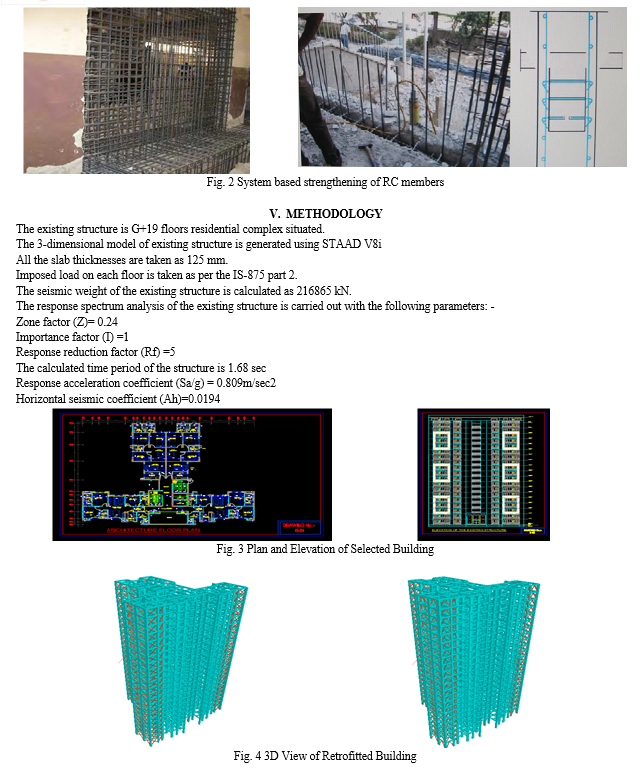
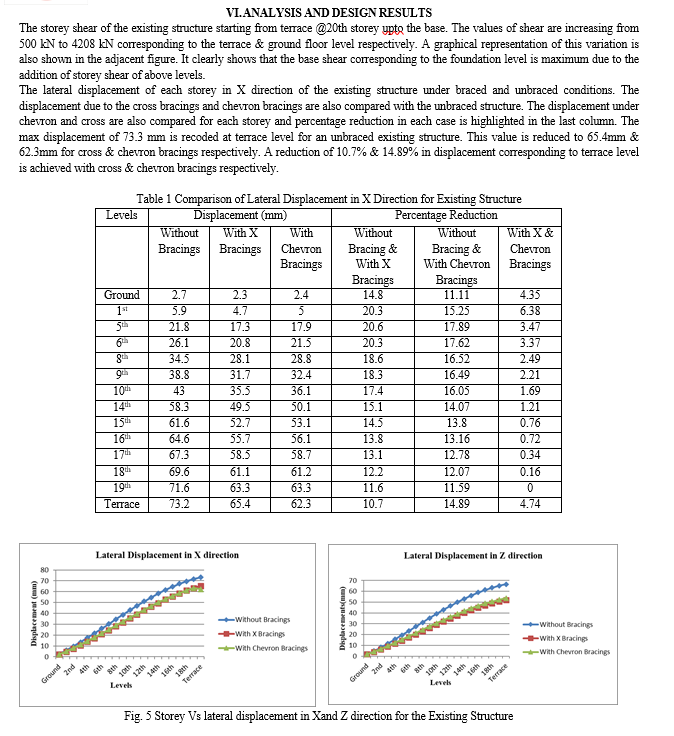
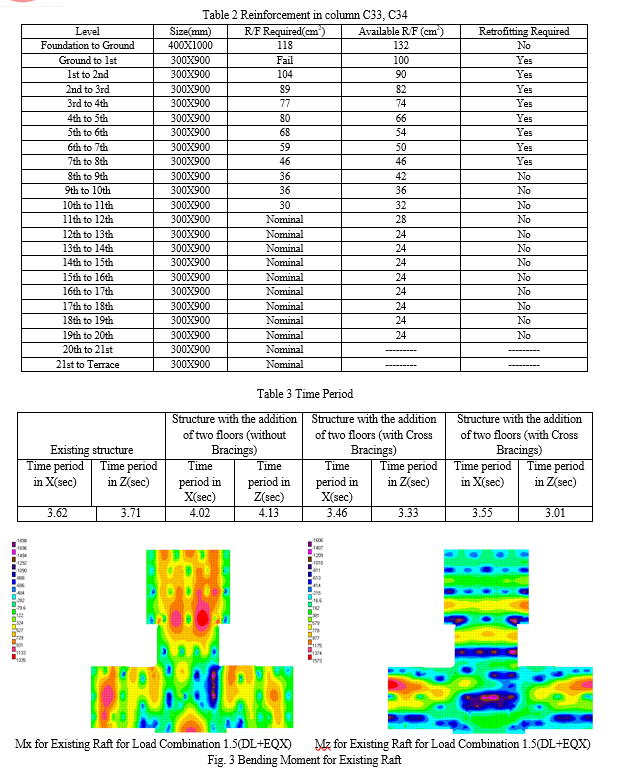
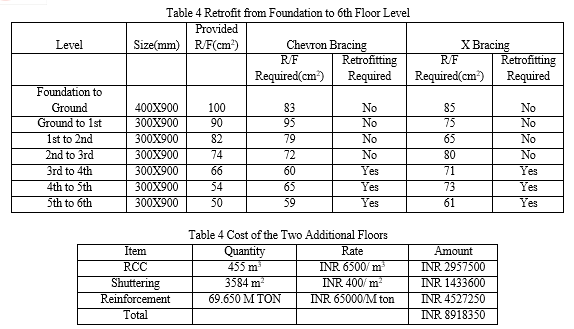
Conclusion
1) The choice of method of retrofitting of the structure depends on the structure, on its specific requirements, as well as its condition, location & geometry. Several methods can usually be considered and compare to find the appropriate best one. To provide greater flexibility in the retrofit scheme. Several methods can be combined and implemented together, combining the advantages of each 2) Strengthening reinforced concrete columns and foundation to resist increased loads of two additional floors by retrofitting with RCC jackets is common engineering practice for strengthening and retrofitting of columns and foundation 3) The RC jacketing strengthening method, unlike other techniques, leads to a uniformly distributed increase in strength and stiffness of columns. The durability of the original column is also improved, in contrast to the corrosion and fire protection needs of other techniques where steel is exposed. 4) Steel bracings are costlier than the RCC jacketing. In our case retrofitting done through RCC jacketing is 17% and 12% cheaper than the retrofitting done through X and Chevron bracings respectively. Among X and Chevron bracing, chevron bracings can save up to 6.5% of cost as compared to retrofit the same structure through X bracings
References
[1] Jong-Wha Bai, “Seismic retrofit for reinforced concrete building structures. “Consequence-Based Engineering (CBE) Institute Final Report, Texas A&M University, 2003 [2] Moehle J. P. “State of research on seismic retrofit of concrete building structures in the U.S.”, US-Japan symposium and workshop on seismic retrofit of concrete structures, 2000 [3] Bush T. D., Jones E. A. and Jirsa J. O. “Behavior of RC frame strengthened using structural steel bracing”, Proc. ASCE, J. Struct. Eng., 2000, 117 (4),1115-1126 [4] Badoux M. and Jirsa J. O. “Steel bracing of RC frames for seismic retrofitting”, Proc. ASCE, J. Struct. Eng., 2000, 116 (1), 55-74 [5] Umehara H. and Jirsa J. O. “Shear strength and deterioration of short reinforced concrete columns under cyclic deformations”, PMFSEL 82-3, The Univ. of Texas at Austin, Tex., 2000 [6] Maheri M. R. and Sahebi A. “Use of steel bracing in reinforced concrete frames”, Eng. Struct., 2000, 19 (12), 1018-1024 [7] Youssef M. A., Ghaffarzadeh H. and Nehdi M. “Seismic performance of RC frames with concentric internal steel bracing”, Eng. Struct., 2007, 29, 1561-1568 70 [8] Gündogmus H. T. “Repair and strengthening of damaged reinforced concrete frames with steel infill frame and prestressing bars.”, M. S. Thesis, middle East Technical University, Ankara, Turkey (February, 1995) [9] Ghobarah A. and Abou Elfath H. “Rehabilitation of a reinforced concrete frame using eccentric steel bracing”, Eng. Struct., 2001, 23, 745-755 [10] Korkmaz K. A. “Earthquake behavior evaluation of R/C structures strengthened with steel bracings”, Dogus Univ. Dergisi, 2007, 8 (2), 191- 2001 [11] Prakash, V., Powell, G., Campbell, S., DRAIN 2D User’s Manual V 1.10, University of California at Berkeley, USA. [12] TS500 – Turkish Code for the Design and Construction of Reinforced Concrete Structures, Turkish Standards Institute, February 2000. [13] ABYYHY – Turkish Code for the Seismic Design of Structures, 2007. [14] SAP 2000 Integrated Software for Structural Analysis and Design. [15] AISC – American Institute of Steel Construction, Inc., 2005. [16] ACI – American Concrete Institute. [17] ACI Committee 318. Building code requirements for structural concrete and commentary (ACI 318M-05). American Concrete Institute, 2005. [18] Albanesi T., Biondi S., Candigliota E. and Nuti C. Experimental analysis on a regular full scale infilled frame. Proceedings of the First European Conference on Earthquake Engineering and Seismology, Geneva, 2006, Paper No. 1608. [19] Baran M. Precast Concrete Panel Infill Walls for Seismic Strengthening of Reinforced Concrete Framed Structures. PhD thesis, Middle East Technical University, Ankara, 2005. [20] Bush T. D., Wyllie L. A. and Jirsa, J. O. Observations on two seismic strengthening schemes for concrete frames. Earthquake Spectra, 2000, 7, No.4, 511-527.
Copyright
Copyright © 2024 Deepak Kumar, Mirza Aamir Baig. This is an open access article distributed under the Creative Commons Attribution License, which permits unrestricted use, distribution, and reproduction in any medium, provided the original work is properly cited.

Download Paper
Paper Id : IJRASET63254
Publish Date : 2024-06-11
ISSN : 2321-9653
Publisher Name : IJRASET
DOI Link : Click Here
 Submit Paper Online
Submit Paper Online

